Despite an ignominious flight number -- MN 911 -- I emerge alive from the rear end of the green, missile-shaped McDonnell Douglas. A cold front is converging on my position, but right now it is still pleasantly cool and breathless on the tarmac.
Michelle and I (we met on the plane) walk under the green wing toward the neat building that is George Airport. It is the only airport in the country with such a spectacular purple and green backdrop.
The large jagged Outeniqua Mountains push against the deadweight of stress that has built up inside me. I feel it begin to shift, and in its place life emerges; grassroots stir in the still dry soil of my soul.
At the conveyor belt my bag arrives first; I bid the young lady, my once-off traveling companion, adieu. I find Jacques Venter, a ranger from Botlierskop Private Game Reserve, at the arrivals exit. He wears a leather cowboy hat and he has that affable good nature that reminds me of Marius Weyers in "The God's Must Be Crazy."
Getting There
Botlierskop is a 20-minute drive from the airport in the direction of Mossel Bay. After two minutes Jacques points out a vervet monkey on the side of the road. I'm still too jaded and sleep deprived to see it. Jacques keeps up a lively conversation. He tells me that Outeniqua means "honey bringers," a Bushmen word, and yes, this area is one of the haunts favored by these original people, the first people of Southern Africa.
Just outside Mossel Bay we turn off the tar road for a short stretch. As the hillsides roar upward around us, I reflect that once the wanted posters went up, the Bushmen, like Al Qaeda, made for the mountains.
Lord of the Rings
Jacques points out a bizarre rock formation rumored to be behind the nomenclature of the place. From the summit of Botlierskop, he tells me, a large fire was made to alert local farmers that ships were coming in and they could start moving fresh supplies to the ships. The fire was lit in the "Lord of the Rings" style after a faraway beacon was set alight near the present Mossel Bay lighthouse.
The rocks here seem to be sculpted by extreme wear and tear: ice, rain and wind. Finding myself similarly weathered by the world of work, the rugged surroundings are a comfort to me. I'm happy to escape the chatter, the clutter, and anything and everything manmade. Just get me away from it all!
 Six-week-old Shima is the newest addition to the Botlierskop Reserve.
Six-week-old Shima is the newest addition to the Botlierskop Reserve. ©2007 Nick van der Leek
From the beach-white dirt road I see a big African elephant towering over a very tiny calf. Jacques tells me the calf is only five weeks old and his parents, both former Zimbabweans, are movie stars. I feel a positive cosmos begin to spark along the deadwood of my spine.
Close Encounters
Soon after passing the pair of elephants, we encounter a large tortoise racing up the dusty road. We stop, Jacques opens the hatch of the bakkie and I climb out to lift the leopard tortoise off the ground, its turtle-like legs still swimming in the air. Jacques tells me it is the most common tortoise species on the African continent.
We drive on, soon approaching a saw-tooth scene of massive tree trunks hewn together. This is the hotel entrance. We drive through the gate and ascend the drive while a series of high, dry boulder-strewn mountains rise like a giant oxidized wave around us. Yes, these porous hills make good hiding; for Bushmen and men of the West who must hide in the mountains to get away from the maddening lights of the city.
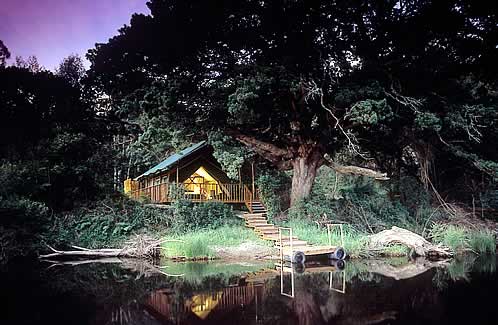 |
 Luxurious tented suites are situated right beside the river. Luxurious tented suites are situated right beside the river. |
| ©2007 Botlierskop Private Game Reserve |
But Jacques' good nature is infectious, and it gets the better of me. He says there is a big wedding on the deck, and they'll make a plan so that I can watch the game on the big screen in the conference room.
African Ethos
When I arrive the decor takes me into Africa. There's thatch, skins, ostrich shells on wrought-iron chandeliers, themed deckchairs and wide light-khaki umbrellas holding off the African sun. All very tastefully and thoughtfully put together. There's a view toward the high purple Outeniqua, a river sprinkled with stars directly below.
Yes, the African ethos is immediately apparent, and to begin with, for a few minutes I completely forget about the rugby game. When I finally settle down to watch, the Tongans give the South Africans a huge run for their money. Somehow we win, but after the game I'm feeling wound up once more. Maybe TV isn't such a good idea, I'm thinking, sipping cool, dry white wine.
On cue a ranger emerges and offers to take me to my suite. My bags are already there he says. We drive down to the Moordkuil river -- so named because a large number of Bushman were rumored to have been killed here -- a blue crane stands between the parked cars, like a very strict parking attendant.
Riverside Tents
We step onto a boat and hum around a bend toward the wooden jetty on the other side. Those few moments on the river, the gurgle and flow of the river continue nature's gentle washing of tired feet and ruffled feathers. I follow the wooden path between the thick green stems of a Cape Ash, and there it is. I'm number 15, Byevanger (Bee Catcher). The Bushmen would have enjoyed that.
I'm perched a few meters directly above the shining river, with forest hugging me on every side. I step across the wooden deck and into the tent. Inside, the floor is pine. There's a big four-poster bed softened with mosquito nets, tastefully arranged wicker chairs -- leather-bound -- and rustic metal lamps giving off a warm golden glow. There are skins on the floor.
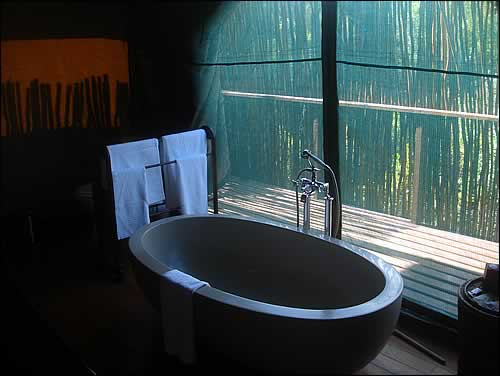 |
 Soak up the sounds and scenery. Taking a bath is just one way to connect to the outside world. Soak up the sounds and scenery. Taking a bath is just one way to connect to the outside world. |
| ©2007 Nick van der Leek |
Au Natural
And that's what it is. All natural. It's the sounds you see that permeate the walls of your riverine abode that are one of the absolute highlights. While in the bath (the water is clean and piping hot) I hear the twitter of birds then, that most African of sounds, the sharp cry of the fish eagle. It's a delight to be so close, so connected to nature. As darkness folds around me, lions roar and an elephant bellows.
Now it's time for the crickets to join the nocturnal symphony. They sing. They sound like really happy crickets. In nature, you know, there is no such thing as noise. There are just sounds, and they do soothe. It washes over me, and the cactus begins to soften. The barbs turn into buds. I get out of the bath suddenly hungry. As I'm getting dressed I get a call: "What drinks would I like served at the Boma?" I put down the phone. I feel like singing with the crickets. The 40-strong staff has thought of everything.
Magical
The rest of the Botlierskop experience is gentle and magical. Whether you eat in the Fireplace Restaurant or the Boma lower down, expect a feast, and a feast of wild meat in particular. You'll have a choice between zebra, kudu, ostrich, warthog, crocodile -- the list goes on. Try to save some space for dessert. The food really is so good it's difficult not to stuff oneself.
You can do a game drive first thing in the morning. Because I slept so well -- the best sleep in months -- I went on the second drive, at 10 a.m. The cold front had already passed over us, so I was glad for the later, warmer start. The tent was cozy since they have electric blankets and heaters in all 19 suites.
Game Drive
Early on the drive we see impala (including the rare black impala) near the owners' residence, white rhino, zebra between the neon-green sunshine cone bushes, giraffe, wildebeest, waterbuck (some people called them kringgatte), bontebok and the most elegant antelope of all, the regal eland.
The eland features a great deal in Bushmen rock art, and it's not difficult to understand why. It is massive, yet it can clear 2-meter-high fences like the kudu. They survive seemingly without effort, and because they draw moisture out of plants and leaves they never have to drink water. The guides are knowledgeable and nice; their enthusiasm about the environment is matched by their warmth to visitors.
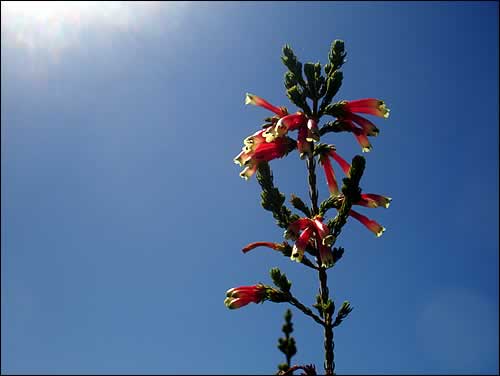 |
 The cigarette bush is pollinated by one bird that has a specially adapted (curved) beak in the same shape as the flowers. The cigarette bush is pollinated by one bird that has a specially adapted (curved) beak in the same shape as the flowers. |
| ©2007 Nick van der Leek |
Our guide shows us the extent of a devastating fire: on one side of the fence thick fynbos, on the other side, short, stunted grass. The advantage is that it is easier to see the wildlife where the grass is shorter. The game drive ends with a visit to a small pride of four lions, and some impressive vistas over the Botlierskop valley.
Helicopter
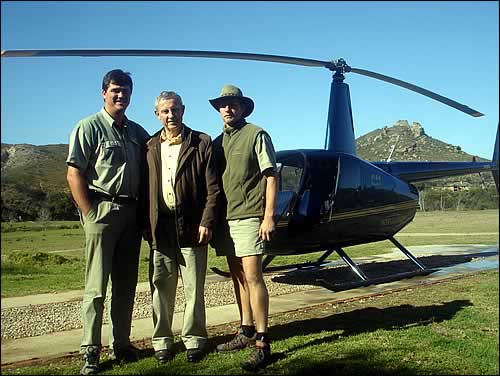 |
 Arnold, Dirk and John, standing in front of the Raven helicopter. Arnold, Dirk and John, standing in front of the Raven helicopter. |
| ©2007 Nick van der Leek |
Dr. Neethling pioneered the breeding of the black impala, and it's thanks to his success with them that he was able to develop Botlierskop into the large-scale success it is today. We flew over the reserve, and then looked beyond, to the seascapes around the Klein Brak River. Helicopter flight is of course totally different to flying in an airplane. There's something faintly God-like in the ability to position yourself in the air wherever you mean to be.
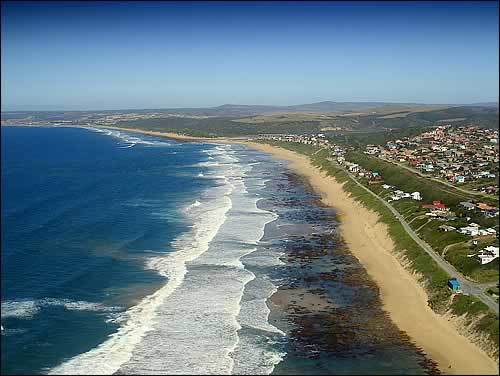 |
 View toward Klein Brak River, a stone's throw from the Botkierskop Reserve. View toward Klein Brak River, a stone's throw from the Botkierskop Reserve. |
| ©2007 Nick van der Leek |
The highlight of a visit to Botlierskop is still to come though. While elephant rides on the movie stars Sam and Tsotsi are a treat, the elephant picnic is even more so. A nice light lunch is served on crisp linen-covered tables out in the open, beside the cool of a large tree and the river sliding by below. You can choose to drink wine, champagne, whatever you want with your meal. Once done, guides bring Tsotsi and the adorable months-old baby elephant, Shimba into the clearing.
 |
 Riding the elehants is one of the highlights at Botlierskop. Riding the elehants is one of the highlights at Botlierskop. |
| ©2007 Nick van der Leek |
Put the apple on the tongue and make sure someone is there to capture the moment. It's a test of mettle. A little girl was too terrified to do it. I laughed seeing how nervous some of the men were, placing their apples in the elephant's mouth, and then pulling back quickly in terror.
The elephants are exceedingly gentle, and your commune with them is likely to be the closest you will get to these gentle and intelligent animals. It's likely to be the most delightful of your experiences at Botlierskop.
First People
The Bushmen chose the Botlierskop Valley as their hunting ground. They had good reasons. It is a giver and restorer of life. Even after fires and floods, the valley still teems with life, from its fynbos and flowers, to the large idiosyncratic animals you'll find all over the reserve.
 |
 Panoramic view of the Botlierskop Valley. Panoramic view of the Botlierskop Valley. |
| ©2007 N. van der Leek |
Standing in the cave, flint stones in my hands, the whorls of my fingers moving over the soft ochre stains, I feel myself moved to the moment when these first people were here, clicking softly in the firelight and hiding from the people who would come in an endless tide in their ships. John and I decide the Bushmen chose this cave as a lookout and a hideaway.
I believe they were happy here, while they lived in this place. They found the full moon, and honey, and a short-term safety from the dangers beyond the valley. When you go, let go of television and the Internet and you will discover the same elixir, like a soft rain falling on dry soil.
It rained on my second day at Botlierskop. I listened to the sounds. I reached out to the animals. The dry soil softened, and I came away fully restored. It seems to me that the way to connect with nature is to find those places specially chosen by the Bushmen in this country. The Bushmen chose places that could look after them. Botlierskop is just such a place.
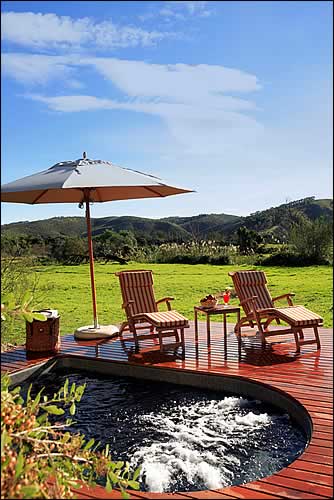 |
 Unwind in the jacuzzi. Unwind in the jacuzzi. |
| ©2007 Botlierskop Private Game Reserve |
Fly Kulula.com from major centers in South Africa to George Airport.
Rates
Special rate of 595 South African rand (US$90) per person sharing per night including Bed and Breakfast.
Terms and conditions:
- Valid now until Dec. 20, 2007.
- Rate quoted is for Luxury rooms only.
- Subject to availability.
- Minimum 2-night stay.
Bushwalks, horseback safaris and further afield: Boat-based whale watching (June to October), Seal Island trips, white shark cage diving.
Contact Information
Visit www.botlierskop.co.za.




















